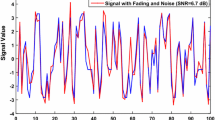Abstract
In this work the blind equalization of a single-input, multiple-output channel has been carried out using second-order statistics. A sufficient and necessary condition for blind equalization based on second order statistics has been given. It has been proved that a single autocorrelation matrix of the source symbols is sufficient for blind equalization. The proposed scheme is generalized; that is, it is valid for white as well as colored source symbols. A linear artificial neural network is developed with a learning algorithm based on the new condition. The results of the new algorithm verify its validity and superior performance.
Similar content being viewed by others
Author information
Authors and Affiliations
Corresponding authors
Rights and permissions
About this article
Cite this article
Naveed, A., Qureshi, I., Cheema, T. et al. Blind Channel Equalization Using Second-Order Statistics: A Necessary and Sufficient Condition. Circuits Syst Signal Process 25, 511–523 (2006). https://doi.org/10.1007/s00034-005-0809-0
Received:
Issue Date:
DOI: https://doi.org/10.1007/s00034-005-0809-0




